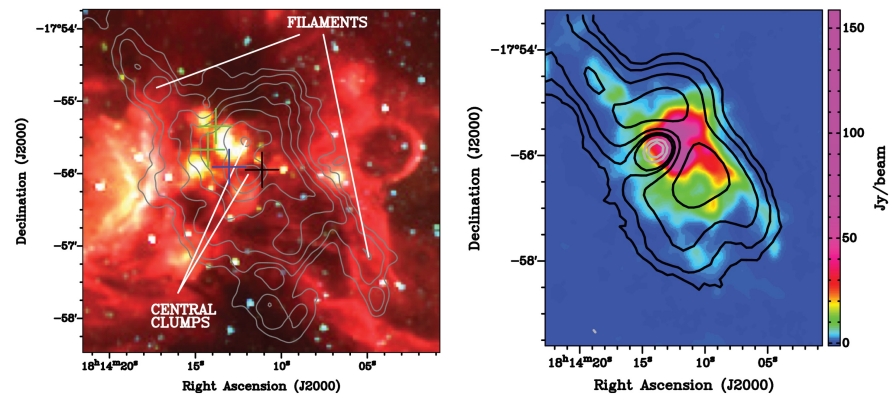Thesis Topic: Cluster formation and accretion flows in the high-mass star forming cluster W33 Main
Thesis Supervisor: Katharina Immer
Abstract
Massive stars play a crucial role in the baryon cycle of the universe, from early cosmic times to the present. However, the process by which these stars form remains a fundamental open question in current astronomy. Put simply, the main challenge lies in understanding how a sufficient amount of gas can gather rapidly within a small region of space to give rise to a massive star. At its core, the key aspect revolves around how gas clouds fragment.
Recent observations of Milky Way star clusters with L > 10^6 L☉ found that they preferentially form in a special environment: the central parsec scale region of the collapsing molecular cloud. However, studying the formation of these very luminous clusters is complicated due to their rareness, owing to the short lifetimes of the massive stars and of their host clouds, compounded by the fact that massive stars are themselves very rare.
High-resolution molecular line observations of these clusters have resolved a similar network of dense gas filaments, converging from >5–10 pc scale to central parsec scale towards high density hubs which harbour the highest mass stars in the clusters. Far-infrared and submillimeter observations have revealed the filamentary morphology of the interstellar medium, highlighting a wide variety of “filament families”, from fibres to giant filaments (see recent review by Hacar et al. 2022). The specific geometry of the filament, fibre, and hub-filament system may allow the ionising radiation of the forming high-mass stars to escape via the inter-filamentary gaps while the reservoir of the hub system is replenished with dense material via accretion flows along the filaments, allowing the formation of massive clusters (e.g. Kumar et al. 2020, 2022). It has then recently become clear that these structures within highly fragmented clouds play a key role in gas flows from filaments down to cores and the concentration of gas required to form massive stars. (e.g. Pineda et al. 2022).
In recent years, the interest in the study of hub-filament systems has significantly increased (e.g. SDC13, Williams et al. 2018; G310.142+0.758, Yang et al. 2023; 17 hub-filament system clouds, Liu et al. 2023). Further investigations on how the fragmentation of the filaments is connected to the OB cluster forming clumps on ~0.1 pc scales in more systems are still needed.
The W33 Main clump, the largest and most massive in the W33 complex, hosts an OB cluster with spectral types ranging from O7.5 to B1.5 (Haschick & Ho 1983). Observations of ionized gas in W33 Main indicate interactions among multiple late-type OB stars. The complex exhibits a filamentary structure, as observed in submillimeter continuum and ammonia line observations (Keto & Ho 1989, Fig. 1). Velocity gradients have been detected both on larger scales across the complex and on smaller scales within the central dust condensation (Immer et al. 2014). By studying clouds like the W33 complex, located at a relatively close distance yet with a substantially varied stellar population, and with the wealth of previous studies and new observations, we can gain insights into the mechanisms that drive the evolution of molecular clumps at different stages.
The main objective of this IMPRS project is to further the understanding of the formation of high-mass star forming clusters in the context of accretion flows in hub-filamentbsystems by investigating the hub-filament system W33 Main and the whole W33 complex. The student will address if there is evidence for accretion flows from the filaments to the central clumps in W33 Main, the physical processes behind the formation of the clumps, specific dynamics of the central clumps and the connection of the small-scale filaments with the larger-scale filaments in the W33 complex. The student will use existing Very Large Array data that covers transitions of the ammonia and methanol molecules as well as radio recombination lines as well as Very Long Baseline Array observations of water masers in W33 Main. The student will furthermore utilise other archival datasets from the Very Large Array and the Atacama Large Millimeter/submillimeter Array for their studies.
The PhD student will gain experience in understanding the formation of filamentary structures and will become an expert in the calibration and analysis of interferometric datasets.
Collaborators: The PhD supervisory team includes Katharina Immer and Ashley Barnes (ESO) as well as experts in Taiwan, Mexico and the US.

Figure caption: (Left) RGB image of Spitzer/GLIMPSE observations of W33 Main (blue = 3.6 μm, green = 4.5 μm, red = 8.0 μm). Contours: CSO-SHARC2 observations at 350 μm. The filaments and the central clumps are indicated. Green, blue, and black crosses show water masers, a star cluster, and a Class I methanol maser, respectively. (Right) CSO-SHARC2 observations of W33 Main at 350 μm. The contours show the integrated emission of the NH_3 (1_1—1_1) inversion transition, observed with the GBT.

